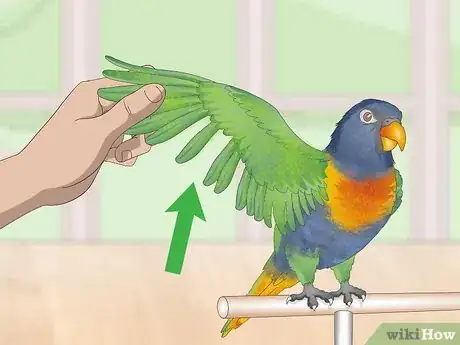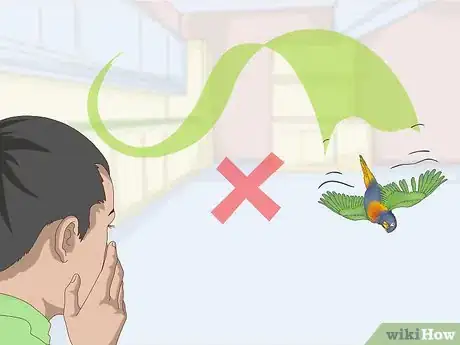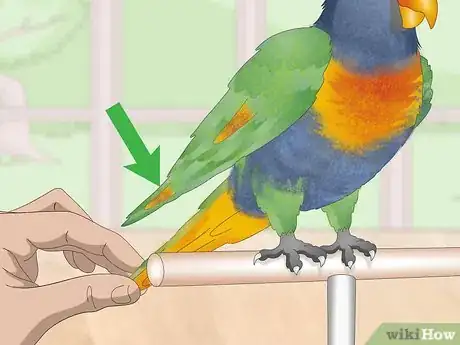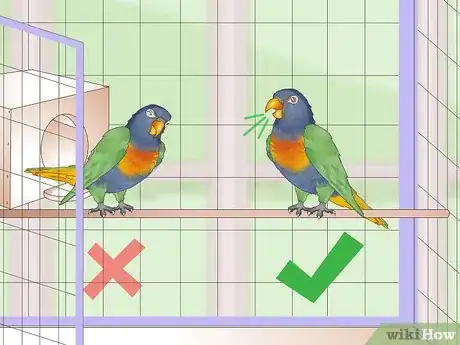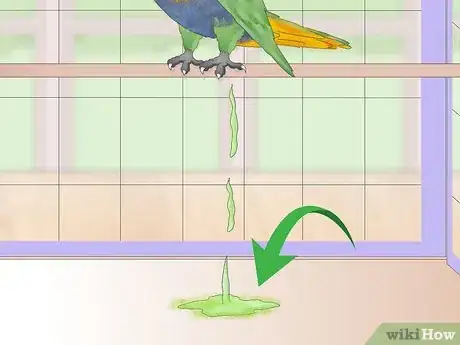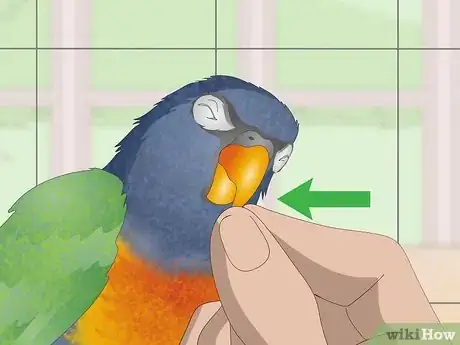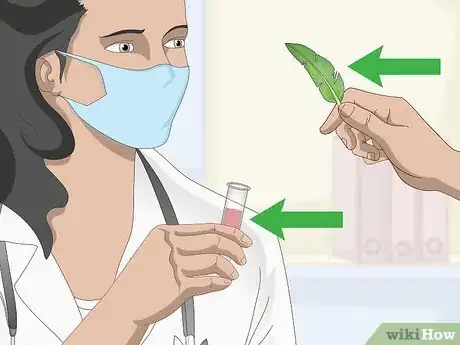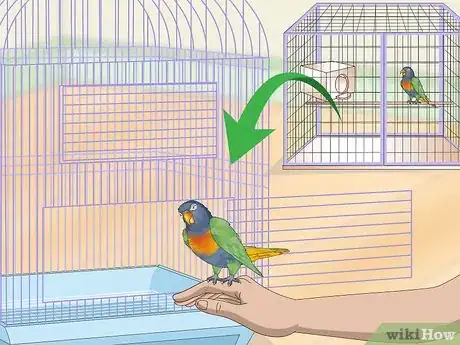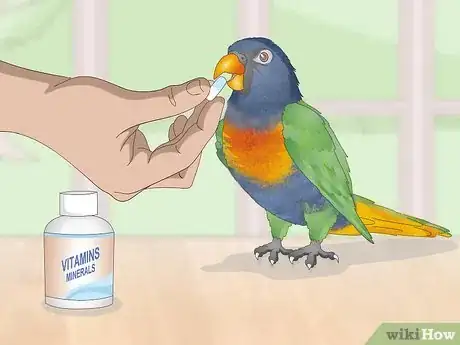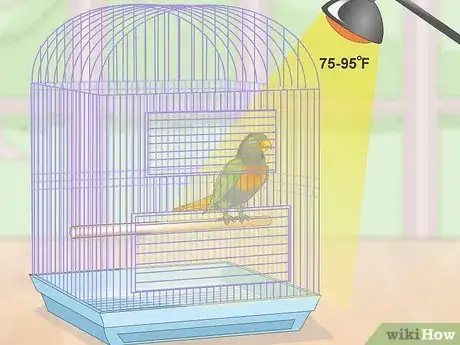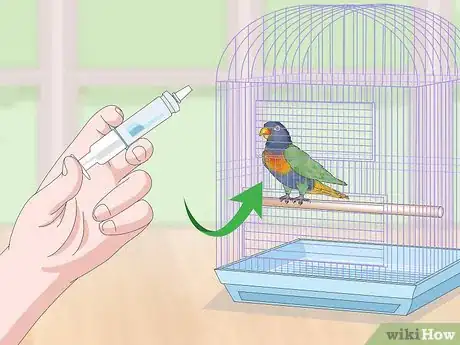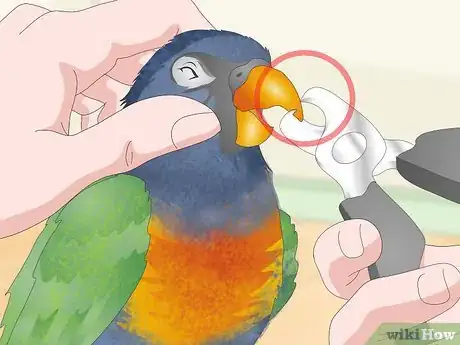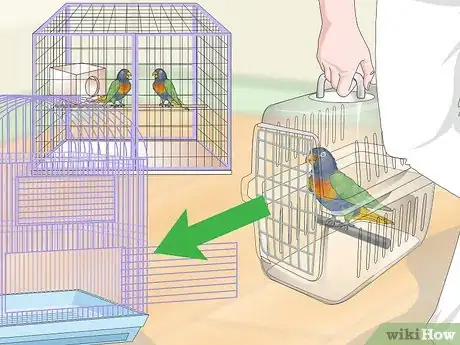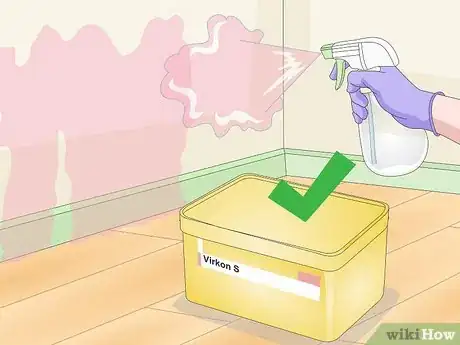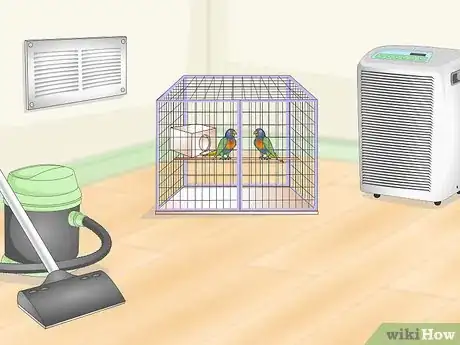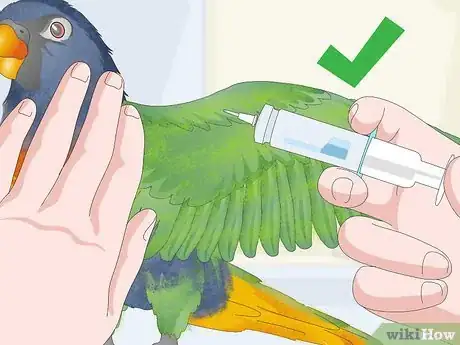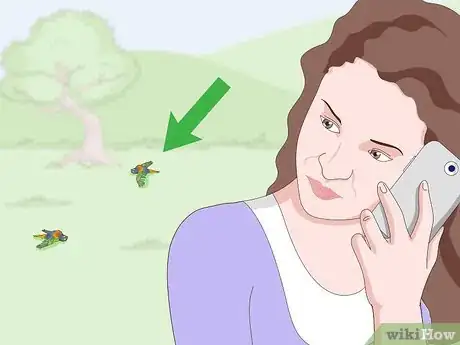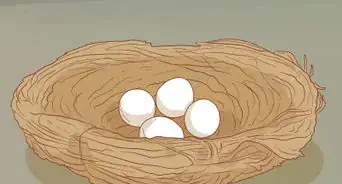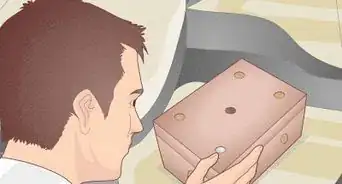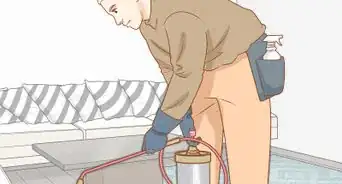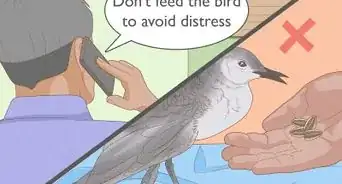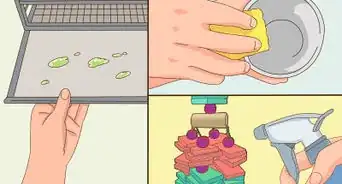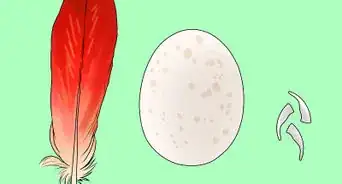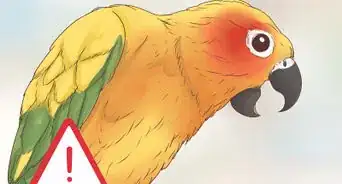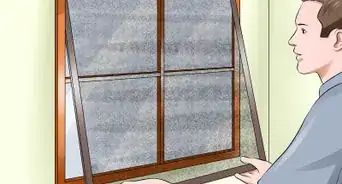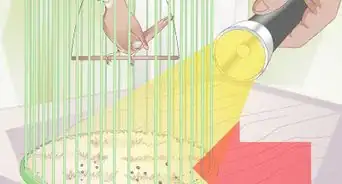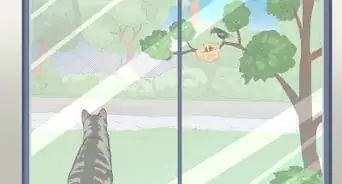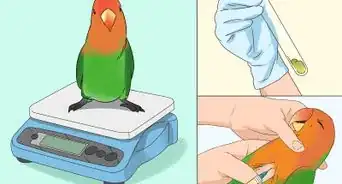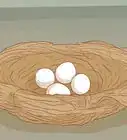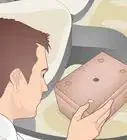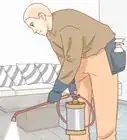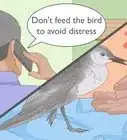This article was co-authored by Pippa Elliott, MRCVS. Dr. Elliott, BVMS, MRCVS is a veterinarian with over 30 years of experience in veterinary surgery and companion animal practice. She graduated from the University of Glasgow in 1987 with a degree in veterinary medicine and surgery. She has worked at the same animal clinic in her hometown for over 20 years.
There are 10 references cited in this article, which can be found at the bottom of the page.
This article has been viewed 36,465 times.
Psittacine Beak and Feather Disease (PBFD) is a highly contagious viral illness that lories and lorikeets can catch through contact with the feathers, feather dust, nesting material, and feces of infected birds. Unfortunately, there is no effective treatment or cure for PBFD. Once you recognize the symptoms and have your bird diagnosed, you can provide supportive care under your vet's supervision. You can also take measures to prevent PBFD in unexposed birds.[1]
Steps
Recognizing the Symptoms
-
1Look for missing feathers. Check the feathers on their wings and tail. Watch out for feathers that fall out easily. You might also see bleeding at the molting site. These symptoms are common in birds infected at a young age.[2]
-
2Check for affected flying ability. Infected birds might fly weakly. Some might lose their ability to fly altogether. This is true whether or not they lose their feathers.[3]Advertisement
-
3Look for discoloration. Familiarize yourself with your bird's natural coloration, especially where they have yellow feathers. Check the tail feathers and primary feathers for patches of yellow in the wrong places. Older birds might develop irregular patches of yellow in their green body feathers.[4]
-
4Check for signs of depression. Pay attention to a drop in vocal activity. Be on the lookout for lethargy, as well. Depression often results from discomfort such as abdominal pain and muscle spasms.[5]
-
5Take note of secondary symptoms. PBFD weakens birds' immune systems and leaves them susceptible to bacterial, fungal, and other viral infections. Call your vet if you see symptoms including:
- Green or mucous-like diarrhea
- Vomiting
- Difficulty eating
- Weight loss[6]
-
6Look at the bird's beak. Beak abnormalities aren't very common in lories and lorikeets, but it never hurts to double check. Familiarize yourself with the normal length of your bird's beak and be on the lookout for any growth. Look for brittleness and fractures. If your bird has advanced PBFD, they might develop a decomposition of the hard palate.[7]
-
7Get your bird tested. If your bird exhibits one or more visible symptoms, take them to the vet as soon as possible. The vet will test their blood, feathers, and feces. They might also perform a biopsy on suspicious feather follicles.[8]
- If your bird tests negative the first time, take them for retesting in one month. Sometimes PBFD is difficult to detect in its early acute stage. Two tests one month apart may be needed to properly diagnose it.[9]
- If your bird tests positive the first time, don't panic. It could be a false positive from affected feather dust in the lab. If the second test comes back positive, start taking action for supportive care.[10]
Providing Supportive Care
-
1Isolate birds you suspect to be infected. Do this as soon as you detect symptoms of PBFD. Maintain enough distance from healthy birds to prevent the spread of the virus through airborne dander. Keep the birds isolated for two months or as long as it takes to get them tested twice.[11]
-
2Give your bird nutritional supplements. In some cases, nutritional supplements can suppress the virus and allow your bird to live a long, healthy life. Typical regimens consist of vitamins, minerals, and probiotics. Ask your vet for specific recommendations and dosages.
- If your bird appears to make a recovery, don't assume they're cured. They'll always be infected and should be kept away from other birds.[12]
-
3Provide supplemental heat. Illness and feather loss can lower a bird's body temperature to dangerously low levels. Purchase an infrared light and a thermometer from your local pet store. Place the light one one side of the cage, so your bird can get to close to it and move away as needed. Maintain the temperature at 25–35 °C (77–95 °F) 24 hours a day.[13]
- Try moving their cage by a window or into direct sunlight for a few hours a day. This will keep them warm while providing Vitamin D, which can boost their immune system.
-
4Treat secondary infections. Because birds with PBFD have weakened immune symptoms, they can die from secondary infections if they're not treated promptly and aggressively. As soon as you see the telltale symptoms, contact your vet. Only they can make the proper diagnosis and prescribe the right treatments.[14]
-
5Trim your bird's beak, if necessary. If your bird's PBFD causes their beak to grow too long, it can affect their ability to eat. Don't try to trim the beak yourself. Take your bird to your vet for a safe and humane procedure.[15]
Preventing PBFD
-
1Quarantine new arrivals. If you already have a bird, keep their new housemates quarantined for about two months. During this time, have the new birds tested for PBFD at least twice (once per month). This is because of the possibility of false positives and false negatives.
- If you decide to release your bird(s) into the wild, have them tested first. Otherwise, you could start an epidemic that could spread to endangered species.[16]
-
2Disinfect your home with with Virkon-S. No known disinfectant can actually kill PBFD. However, Virkon-S can deactivate it. First, clean affected surfaces of all organic matter. Then, apply a 2-percent concentration of the compound to all affected surfaces. Let it stay on the surface for at least 10 minutes to be effective. After the 10 minutes has passed, rinse the surface with water to prevent corrosion.
- The 2-percent concentration of Virkon-S is safe for humans and birds. However, if the affected area has poor ventilation, play it safe and move the birds to another room.[17]
- You can buy Virkon-S at many online retailers. Simply enter “buy Virkon-S” into your favorite search engine.
- Anything that comes in contact with the infected birds can spread the disease. This includes your clothing and any items in the bird's cage.
-
3Control dust in your home. PBFD can be transmitted by inhaling infected dust. Install a pleated filter on your furnace and place an electrostatic precipitator on the nearest return air duct. Use room-size air cleaners and vacuum cleaners with HEPA filters. Standard filters won't control dust as effectively.[18]
-
4Vaccinate unexposed birds, if possible. Australian vets have seen promise in an experimental vaccine involving a dead virus. It works best in birds age 14 days and younger. Take your bird(s) to the vet as soon as possible to test for strains of the virus. If they test negative twice, return to the vet in one month for a booster.[19]
- Have adult birds vaccinated one month before you plan to breed them, as PBFD can be transmitted from mother to offspring.[20]
-
5Report suspicious deaths in the wild. PBFD in wild populations is most common in Australia and New Zealand. If you live in these or other area where exotic birds live in the wild, be alert for deaths of parrots, cockatoos, and budgies in groups of three or more. Report them to your local government provider of environmental protection.[21]
Warnings
- Some lorikeets have spontaneously recovered from PBFD, but these are rare instances and the reasons aren't yet known. If the virus is in its acute stage, your only choice might be euthanasia.[23]⧼thumbs_response⧽
References
- ↑ http://www.awrc.org.au/uploads/5/8/6/6/5866843/awrc_michael_pyne.pdf
- ↑ http://www.awrc.org.au/uploads/5/8/6/6/5866843/awrc_michael_pyne.pdf
- ↑ http://www.awrc.org.au/uploads/5/8/6/6/5866843/awrc_michael_pyne.pdf
- ↑ http://www.awrc.org.au/uploads/5/8/6/6/5866843/awrc_michael_pyne.pdf
- ↑ http://www.theparrotsocietyuk.org/veterinary-advice/psittacine-beak-and-feather-disease
- ↑ http://www.brisbanebirdvet.com.au/Portals/brisbanebirdvet/pdf/BBV_Psittacine-Beak-and-Feather-Disease.pdf
- ↑ http://www.awrc.org.au/uploads/5/8/6/6/5866843/awrc_michael_pyne.pdf
- ↑ http://www.merckvetmanual.com/exotic-and-laboratory-animals/pet-birds/viral-diseases-of-pet-birds
- ↑ http://www.theparrotsocietyuk.org/veterinary-advice/psittacine-beak-and-feather-disease
- ↑ http://www.merckvetmanual.com/exotic-and-laboratory-animals/pet-birds/viral-diseases-of-pet-birds
- ↑ https://data.environment.sa.gov.au/Content/Publications/beak_and_feather_disease.pdf
- ↑ https://www.environment.gov.au/system/files/resources/9b85a93b-00c1-43d2-9e4f-bb6279e956e6/files/beak-feather-disease-and-other-threats-australian-threatened-parrots.pdf
- ↑ http://www.awrc.org.au/uploads/5/8/6/6/5866843/awrc_stacey_gelis.pdf
- ↑ http://www.awrc.org.au/uploads/5/8/6/6/5866843/awrc_michael_pyne.pdf
- ↑ http://www.peteducation.com/article.cfm?c=15+1829&aid=2592
- ↑ https://data.environment.sa.gov.au/Content/Publications/beak_and_feather_disease.pdf
- ↑ https://www.environment.gov.au/system/files/resources/9b85a93b-00c1-43d2-9e4f-bb6279e956e6/files/beak-feather-disease-and-other-threats-australian-threatened-parrots.pdf
- ↑ http://www.thisland.illinois.edu/57ways/57ways_44.html
- ↑ https://www.researchgate.net/publication/24011458_Assessment_of_recombinant_beak_and_feather_disease_virus_capsid_protein_as_a_vaccine_for_psittacine_beak_and_feather_disease
- ↑ http://www.peteducation.com/article.cfm?c=15+1829&aid=2592
- ↑ https://data.environment.sa.gov.au/Content/Publications/beak_and_feather_disease.pdf
- ↑ http://www.brisbanebirdvet.com.au/Portals/brisbanebirdvet/pdf/BBV_Psittacine-Beak-and-Feather-Disease.pdf
- ↑ http://www.brisbanebirdvet.com.au/Portals/brisbanebirdvet/pdf/BBV_Psittacine-Beak-and-Feather-Disease.pdf
About This Article
To treat psittacine beak and feather disease in lories or lorikeets, take it to the vet as soon as you notice symptoms, like missing feathers, changes in feather color, or depression. If your bird is diagnosed with psittacine beak and feather disease, you'll need to isolate it from your other pets so the condition doesn’t spread. Additionally, give your bird vitamin, mineral, and probiotic supplements, which can help suppress the virus. You should also provide extra heat with an infrared light, since infected birds find it harder to stay warm. For tips from our Veterinary co-author on when to take your bird to the vet, read on!
